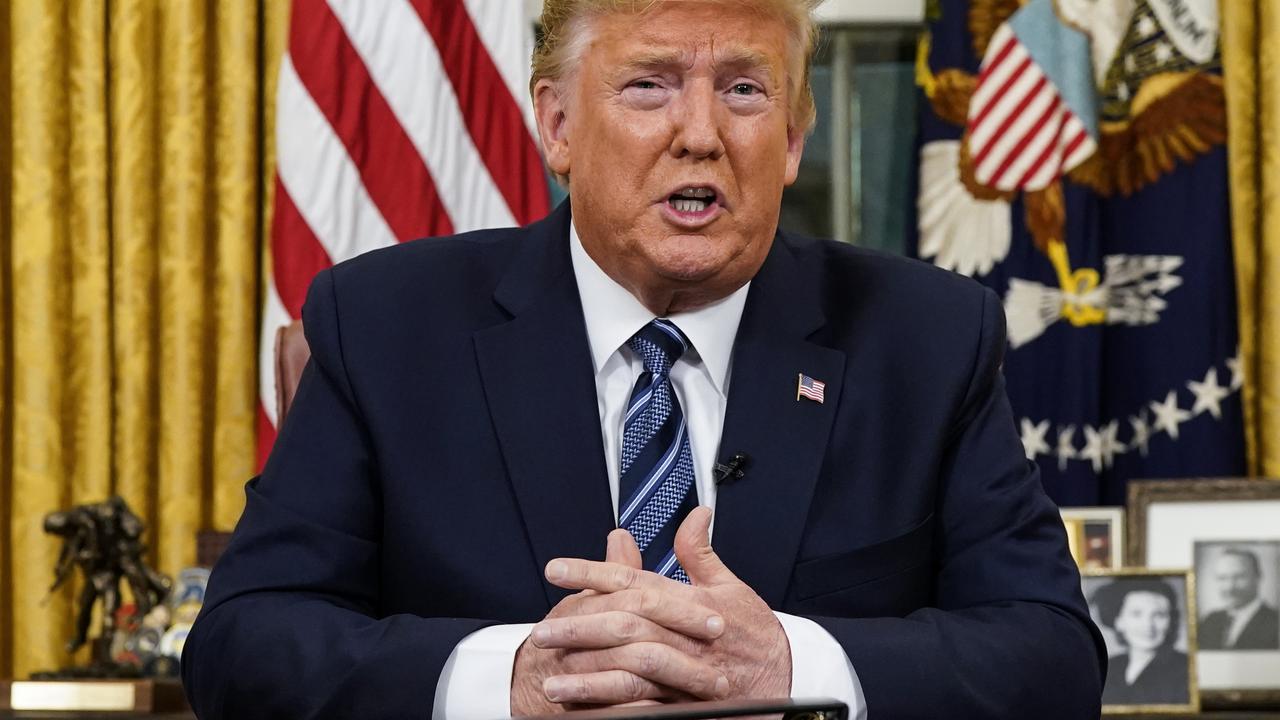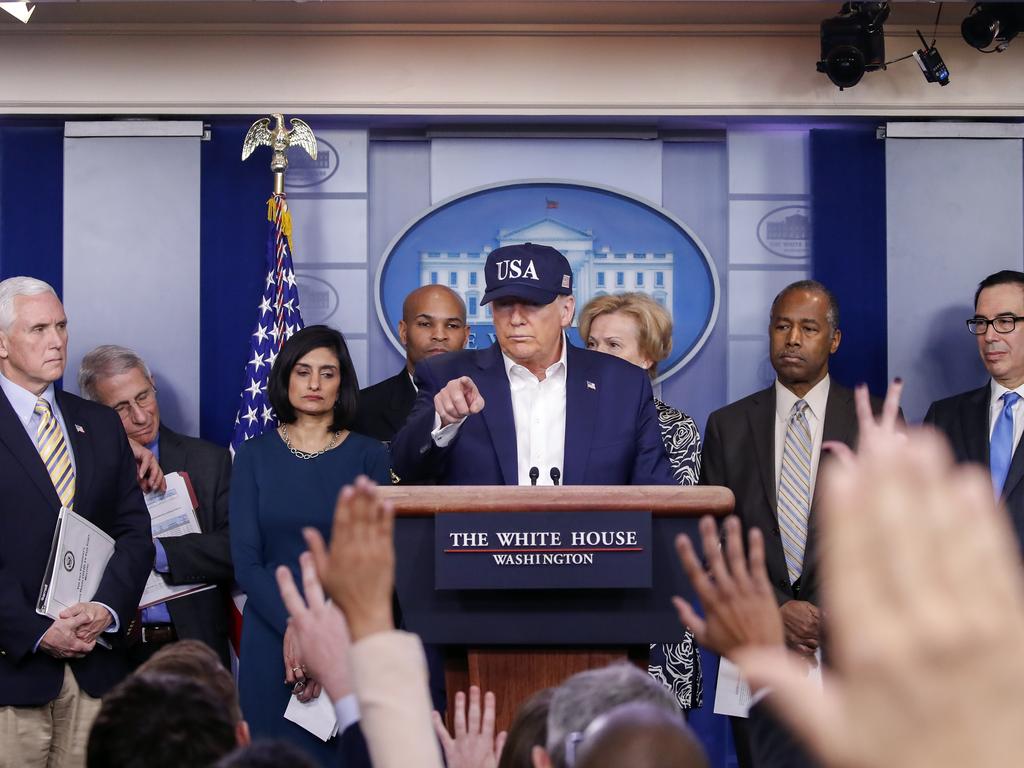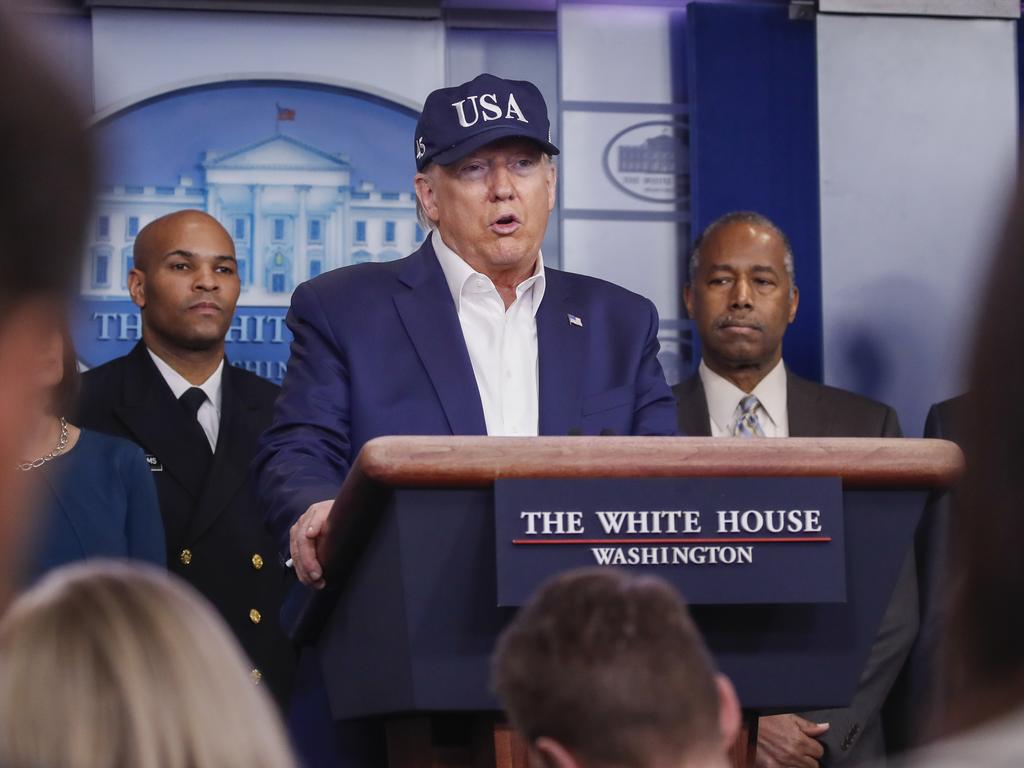Coronavirus: Donald Trump declares a national emergency, extends travel ban, tested for virus
President Donald Trump was tested for coronavirus on Saturday and the chief White House physician just received the results.

President Donald Trump has tested negative for the new coronavirus, according to the president’s personal physician.
The White House released the test results Saturday night after Trump told reporters hours earlier that he had taken the coronavirus test, following days of resisting being screened despite the fact that he had been in recent contact with three people who had tested positive for the virus, including members of the Brazilian president’s delegation who visited with him at his Florida resort.
“One week after having dinner with the Brazilian delegation in Mar-a-Lago, the President remains symptom-free,” Sean Conley, the president’s physician, said in a memo.
RELATED: Follow the latest on coronavirus here
RELATED: What Australians need to know about coronavirus
RELATED: Brazil’s president reportedly has coronavirus
It comes as The United States expanded the European coronavirus travel ban, adding Britain and Ireland to the list.
Trump also told reporters at a White House briefing that he had his temperature taken and it was “totally normal” before stepping into the room to discuss the government’s efforts to halt the spread of the virus.

The president has made a decision to suspend all travel” to Britain and Ireland effective at midnight on Monday, Vice President Mike Pence said at a White House press briefing on Saturday.
The action came after “a unanimous recommendation” from “all of our health experts,” Pence said, as the number of coronavirus cases surge in those countries.
In Britain, the death toll on Saturday nearly doubled from the previous day, to 21.
“They’ve had a little bit of activity, unfortunately,” Trump told reporters earlier in the briefing. “If you don’t have to travel, I wouldn’t do it.”
The ban will apply to anyone who was physically present in Britain and Ireland in the 14 days prior to their attempted entry to the US.
Pence specified that US citizens “can come home” and will be “funnelled through specific airports and processed”.
They will undergo medical screening and will be asked to self-quarantine for 14 days.
Certain visa holders, foreign diplomats and some others are also exempt from the restrictions.
COVID-19 UPDATE https://t.co/xzSHlNiS9K
— Donald J. Trump (@realDonaldTrump) March 14, 2020
TRUMP HELD OUT TESTING FOR DAYS
The pandemic has now infected more than 2,200 people in the U.S. and caused at least 50 deaths.
Trump had held out on testing for days - concerned that it would make him appear weak - despite his interactions with at least three people who have since tested positive for COVID-19.
Trump had said Friday that he would “most likely” submit to testing “fairly soon,” but the White House doctor said in a memo released shortly before midnight that no test was called for, despite the contact, because he wasn’t exhibiting symptoms like a fever or cough.

The president said he’d gone ahead with it anyway after repeated questions from reporters at a news conference Friday and would have the results in “a day or two days, whatever it is.” Vice President Mike Pence, speaking at the same briefing, said he and his wife, Karen Pence, would also “be more than happy to be tested,” despite the doctors’ guidance, and would be contacting White House medical staff to arrange it.
Multiple lawmakers and countless citizens across the country who have had the same degree of exposure have not only tried to get tested, but also chosen to quarantine themselves as a precaution and to avoid potentially infecting others.
The president, according to two people close to the White House, had been reluctant to take the test for fear it would project weakness or worry.
Trump has wanted to appear in full control during the crisis, and had expressed concerns that taking personal steps could undermine that appearance. But as the White House grapples with repeated exposures by Trump and multiple senior aides, it has tightened precautions.
— Donald J. Trump (@realDonaldTrump) March 14, 2020
On Saturday, the White House announced that it is now conducting temperature checks on anyone who is in close contact with Trump and Pence, including reporters who attended the Saturday White House briefing.
To that end, a representative from the White House physician’s office took the temperature of members of the media at the briefing, going around and putting the device to their heads. One reporter with a suspected elevated temperature was not allowed in.
Trump, 73, is considered to be at higher risk of complications from the disease because of his age. He has long tried to minimize the threat posed by the virus and continued to engage in behaviors that health officials are warning the public against.
On Friday, Trump shook the hands of multiple officials at his Rose Garden news conference and he has continued to appear at large gatherings despite tweeting Saturday morning that Americans should be practicing “SOCIAL DISTANCING!”
“It almost becomes a habit,” Trump said when asked why he continues to shake hands contrary to Centers for Disease Control and Prevention guidelines.
“People come up to me, they shake hands, they put their hand out, it’s sort of a natural reflex.,” he said.
“We’re all getting out of it. All of us have that problem.”
He added: “Shaking hands is not a great thing to be doing right now, I agree.”
Just had a nice conversation with Prime Minister @JustinTrudeau of Canada. Great to hear that his wonderful wife Sophie is doing very well. The United States and Canada will continue to coordinate closely together on COVID-19.
— Donald J. Trump (@realDonaldTrump) March 14, 2020
Trump has now had multiple direct and indirect contacts with people who have since tested positive for the virus, including three people he spent time with last weekend at his Mar-a-Lago club in Florida.
The Brazilian Embassy in Washington said late Friday that the country’s charge d’affaires, Nestor Forster, tested positive after sitting at Trump’s dinner table. So, too, have a top aide to Brazilian President Jair Bolsonaro, who took a photo with Trump and attended a party with him, and another person who attended a campaign fundraiser with the president that Sunday, according to two Republican officials who spoke on condition of anonymity in order to discuss private health matters.
Several top administration officials, including Attorney General William Barr and Trump’s daughter and senior adviser, Ivanka Trump, also met last week with an Australian Cabinet minister who on Friday was confirmed positive.
The White House has been saying, citing CDC guidelines, that the president and other White House officials don’t need to be tested or isolate themselves unless they are exhibiting symptoms, even though that advice is contradicted by many health professionals who note that the virus can be spread even by people who are asymptomatic.
The reporter who was not allowed into the White House briefing Saturday had a temperature above the 100.4-degree guidelines in three checks over 15 minutes, tweeted Pence’s spokeswoman, Katie Miller, citing the White House Medical Unit.
Public health officials say that people with a cough and elevated temperatures of 100.4 degrees or higher are deemed concerning.

TRUMP DECLARES NATIONAL EMERGENCY
Donald Trump declared a national emergency in response to the coronavirus pandemic Saturday morning AEST.
In a press conference at the White House, the US President announced he would sign a measure under the Stafford Act that would unlock up to US$50billion in disaster aid from the Federal Emergency Management Agency to help federal and state governments fight the outbreak.
“To unleash the full power of the federal government, I am officially declaring a national emergency,” Mr Trump said as the country continues to shut down.
“Two very big words.”
Trump also announced a shift in his personal approach to the pandemic, saying he would “most likely” get tested “fairly soon” for coronavirus.
“Fairly soon, we’re working on that, we’re working out a schedule,” he said, clarifying that it was not because he feared his potential exposure “but because I think I will do it anyway.”
A Brazilian official tested positive after visiting Trump’s Mar-a-Lago resort last weekend and the president’s daughter Ivanka met Peter Dutton in the US before the Australian Home Affairs minister returned home and tested positive.
Trump, who had previously stated he wouldn’t be getting tested, declared his change of heart at the White House Rose Garden news conference at which he unveiled the state of emergency.
The move will empower the Federal Emergency Management Agency to take a hands-on role by setting up temporary medical facilities and providing logistics in hard-hit areas across the country.
Mr Trump also urged states to set up emergency operation centres immediately.
As of Friday afternoon local time, the virus had spread to 46 of America’s states.
The Colorado state capital Denver declared a public health emergency after a dramatic overnight rise in the state’s number of COVID-19 cases, from 49 on Thursday to 72 on Friday.
Denver Mayor Michael Hancock banned events at city-owned facilities and several Colorado counties banned gatherings of more than 50 people.

Mr Trump said Friday he did not believe all Americans should rush to be tested for the virus.
“We don’t want people to take a test if we feel that they shouldn’t be doing it. And we don’t want everybody running out and taking — only if you have certain symptoms,” he said in the Rose Garden.
Also speaking at the conference, Anthony Fauci, the director of the National Institute of Allergy and Infectious Diseases, said the decision would “remove the constraints” on health, state and local officials containing the virus.
“We still have a long way to go. There will be many more cases. But we’ll take care of that and ultimately, as the President said, this will end,” he said.
The pandemic has already forced the cancellation of most major sporting events, more landmarks shuttered, schools closed to millions of students, and the curtains drawn on Broadway shows across the US.
LIVE: President @realDonaldTrump holds a news conference https://t.co/D975UkADhj
— The White House (@WhiteHouse) March 13, 2020
The Dow surged 1985 points — its biggest single-day gain ever — as President Trump declared the national emergency.
The record rally — which came a day after the blue-chip index suffered its worst drop in more than three decades — came late in the afternoon after Trump unveiled a $50 billion war chest to fight the deadly bug.
The Dow Jones industrial average rose 1985 points, or 9.4 per cent, to close at 23,185.62 — almost enough to erase Thursday’s heart-stopping drop of 10 per cent, or 2352.6 points.
The S&P 500 and Nasdaq, which likewise have been battered into bear territory this week as fears about the epidemic’s spread continued to escalate, both jumped 9.3 per cent.
“We finally got a grown-up response from this White House,” said Alexander Craig of Tiverton Trading.
“It looks like there’s going to be actual stimulus, which is what was needed because this crisis was all about confidence. [The president] finally acknowledged this virus and he’s finally throwing money at it.”
— with Thornton McEnery, New York Post



